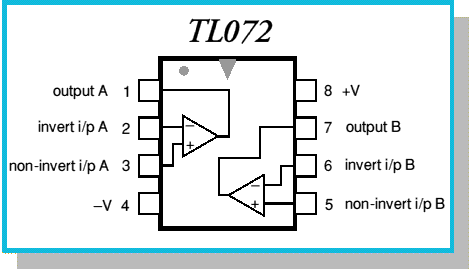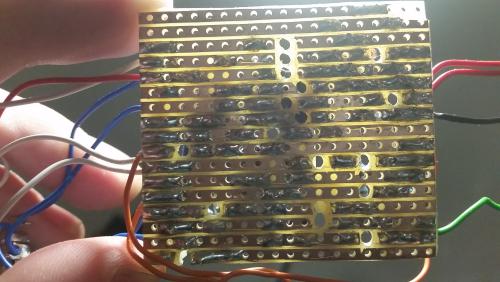Rc Booster no (guitar) Signal
|
Hey Guys,
I'm having a problem with my RC Booster build. Can anyone point me in the right direction? The volume pot has an audible effect (gets louder. Comparable with a plugged in guitar with the volume down and then turning your amp up. So the output stage is fine(?) ? Just no guitar signal. I doublechecked everything, seems to be fine. Knifed and reflow most of the solder. Im using a (working) testrig, so the offboard should be fine. Voltages are off though; Q1: E= 0,01 B= 0,01 C= 9,07 Q2: E= 7,66 B= 5,75 C= 9,07 IC= 1= 8,47 8= 9,07 2= 8,10 7= 8,48 3= 8,25 6= 8,18 4= 8,43 5= 8,88 So I guess the problem is around Q1? I was out of sockets :( So I thought I ask you guys what the problem could be before I try to solder it out... Hope someone has an idea. If pics are needed I can take some! Thanks |
Re: Rc Booster no (guitar) Signal
|
Hi Marbles
Your IC voltages look way off too. Looks like you missed a ground. Pin 4 is directly connected to the ground wire and should be 0V. Have another look over and if still no joy post some pics Good luck |
|
Thanks so much for replying Ciaran!
I'll check when I get home right away :) |
|
This post was updated on .
There is a way to know what the IC voltages should be when debugging a circuit with a typical dual op amp configuration like the TL072 (see below).
In most audio (i.e. AC) circuits, you set the DC bias to 1/2 of your supply voltage, with Pin 1 set to the supply voltage and Pin 4 set to ground (0 V). If your supply is 9V, then for a typical AC gain stage, you should see a DC voltage ~4.5V on the inputs and outputs (pins 2-4 and 5-7). Note that you should have your voltmeter set to DC voltage readings. Most problems I see with IC voltages are because the ground or supply are miswired. However, in a recent OD-808 build, I was getting no output and I noticed that my IC input/output voltages at the gain stage were 2V instead of 4.5V. After a lot of checking, I saw that one of my track cuts wasn't complete (grrr!) - after fixing that, it worked like a charm. 
|
|
In reply to this post by Ciaran Haslett
Thanks for the explanantion! Yes, my voltages are way off then..
I have knifed like a madman again (poor vero, afraid im going to slice it in half). Voltages now are : Q1: 9.07 0.46 0.18 Q2: 9.07 5.75 7.67 IC: 1: 8.44 8: 9.07 2: 8.07 7: 8.44 3: 0.03 6: 8.15 4: 0.00 5: 8.84 I will now embarrasingly add photos. The knifing has left it's mark. I tried to put a light behind it, cause a lot of cuts look like bridges.. But yeah, not the best job.  
|
|
Based on the voltages, it seems like the biasing is screwed. I'm going to guess you have a cold solder joint in the jumper underneath the IC. Remelt those joints and see what happens.
|
|
Very well possible I did not reflow that solder. Will try that when I'm home from work. Thanks for your help too.
What is the most likely cause for bad solderjoints? If this is the case, it would have been the second circuit this week that suffered from that.. The soldering on this one is not really representive for my usual soldering, but it could be technique? Another cause I noticed (in a former project) was the vero getting dark. Probably corrosion from me touching it too much? I'm using a 30€ soldering iron right now, but am thinking about upgrading to a Hakko Fx-888D. Is that a good investment? |
|
When I prep a vero board for use, I have a sanding block with 1500 grit automotive finishing paper. I use this to remove any surface corrosion and then wipe it down with a clean cloth. (Try not to get too aggressive with the block, otherwise you may take off too much copper from the traces). I then check every track cut for continuity with my DVM (sometimes one or two will slip by). And check your cut holes for stray strands of copper - all it takes is one little bit to cause a bridge!
I also get a cold solder joint every now and then. I find that high heat and good soldering technique helps. Also, inspect every joint after soldering - sometimes I'll reflow a spot if it looks iffy. |
|
In reply to this post by Marbles
Tarnished veroboard will lead to cold solder joints, as the oxide layer will stop the solder flowing. This can get really bad if you suffer from Rustfinger Syndrome
As Frank says, use very fine abrasive paper, or use an abrasive rubber block. You can pick these up cheap in model shops for cleaning the tracks on train sets and slot racer cars. They are also sold as fret cleaning blocks for guitars. Cut your board to size and give the copper a quick rub over to get it nice and shiny before stating to solder. It work wonders. Not used the Hakko iron - I have a Xytronic station, which I think are more common in Europe, but they are pretty popular on here, and a decent soldering iron regardless of brand, really is worth every single penny, so go for it. |
|
Besides oxidation, cold solder joints often come from poor technique. Simply melting solder onto a component leg will lead to cold joints. The leg and pad must be hot before the solder is applied.
After installing the component, heat the leg and pad with the soldering iron, then apply solder. Most component legs are small enough that only a fraction of a second of heating is required. Never touch the iron to a component for more than one second at a time. Ge components and many IC's are easily damaged by overheating. There are many written and video tutorials on the web that go into more detail. |
|
In reply to this post by induction
You were right on the money Induction. Hats of to you. I checked the tiny jumper underneath the IC (which i did not reflow cause it's so much solder close together) and bingo! One leg was sticking out with no solder touching. I completely missed that.
Reflowed it and, after a few coughs, it fired up! Thank you all for helping me out in this. Much appreciated. Will definitely clean my board before starting. My technique now was, ehm, cutting the board and finishing it before it had time to corrode :) Soldering iron will be ordered too. I'm making a lot of pedals these days so will def take your advise by getting a better one. I noticed that sometimes I have a bit of trouble heating the parts or track up, and 'helping it' by premelting the solder a bit with the iron. Thanks for your time! |
|
Administrator
|
marbles, man it happens to the best of us and is one of the most annoying problems to find. i was just looking over the thread and saw you ask about the hakko soldering station. i don't have it, but i know a few people that do, and it's a great piece. i was looking at one of the hakko units, i forget which one, but went with the edsyn 951SXe instead. what swayed me to the edsyn is that iron is a 90Watt iron, is industrial grade, made in the US (for me i prefer to support american companies and american made products), and that it's NOT digital. i firmly believe that the simpler the better, it's a soldering iron, it doesn't need a bunch of bells and whistles, not to metnion i just don't trust the digital ones.
for years i used one of 2 wellers. one was my dads from the later 60's, and a newer one that cost me like $30, that i only bought because i kept hoarding his and he could never find it when he needed it. with that being said, cold joints happen no matter what iron you use. i do think my soldering got better with the edsyn, now is it because it's a better iron, or because of a placebo effect, i can't say. what i do to prep my boards is similar to what frank and beaker do. i make my cuts, cut the board to size, then lightly go over the copper with 1500 grit sandpaper then a few quick wipes with either acetone or alcohol to make sure there's no oils on it and to remove any shavings. |
|
That's great :)
As a dutchman, it's hard to support local products, don't think we have any good soldering iron products here :D I totally agree with you on the 'simpler he better'. If I could find the non-digital Hakko I would buy that instead without thinking. Especially cause I have read that the Hakko 888D has a weird thing that when you press the plus button (you'd think that means higher temperature), you instead mess with the calibration and you're temperature could be way off with the displaytelling you it's fine. That's a big risk for me. I'm going to use it in the same setting all the time anyway I think, so I won't mess with it probably. BUt yeah, a lot of stuff I have no use for as well. But apart from this, I have read nothing but good stuff. If that Edsyn was for sale here, I could see myself considering that, but unfortunately. I heard a lot of people complain about the newer stuff from Weller, so that's of my list as well. I think I'll be ordering the Hakko.. Sure it will benefit my technique. Even if it's placebo ;) |
«
Return to Debugging
|
1 view|%1 views
| Free forum by Nabble | Edit this page |

